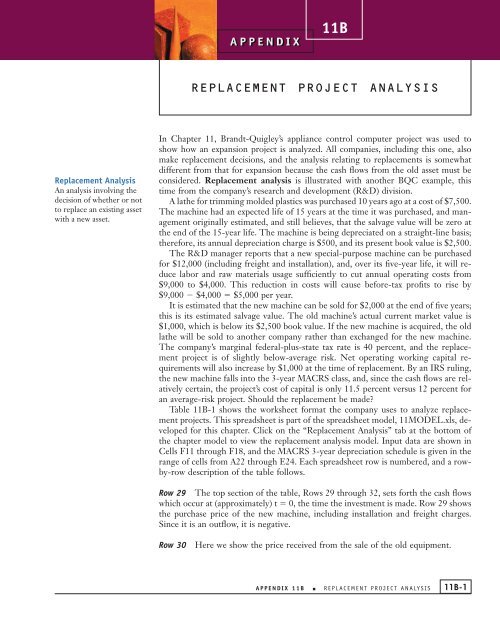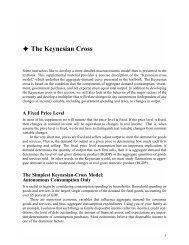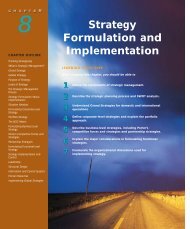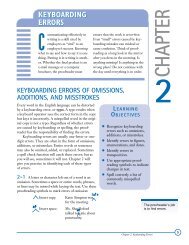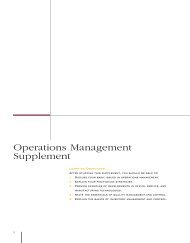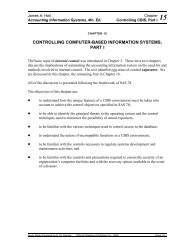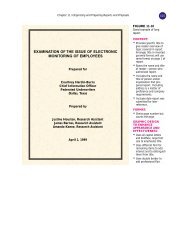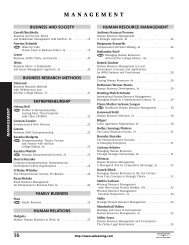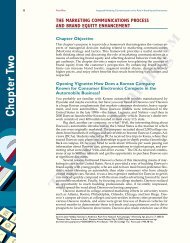REPLACEMENT PROJECT ANALYSIS
REPLACEMENT PROJECT ANALYSIS
REPLACEMENT PROJECT ANALYSIS
Create successful ePaper yourself
Turn your PDF publications into a flip-book with our unique Google optimized e-Paper software.
App11B_SW_Brigham_778312_R2 1/6/03 9:12 PM Page 11B-1<br />
Replacement Analysis<br />
An analysis involving the<br />
decision of whether or not<br />
to replace an existing asset<br />
with a new asset.<br />
11B<br />
<strong>REPLACEMENT</strong> <strong>PROJECT</strong> <strong>ANALYSIS</strong><br />
In Chapter 11, Brandt-Quigley’s appliance control computer project was used to<br />
show how an expansion project is analyzed. All companies, including this one, also<br />
make replacement decisions, and the analysis relating to replacements is somewhat<br />
different from that for expansion because the cash flows from the old asset must be<br />
considered. Replacement analysis is illustrated with another BQC example, this<br />
time from the company’s research and development (R&D) division.<br />
Alathe for trimming molded plastics was purchased 10 years ago at a cost of $7,500.<br />
The machine had an expected life of 15 years at the time it was purchased, and management<br />
originally estimated, and still believes, that the salvage value will be zero at<br />
the end of the 15-year life. The machine is being depreciated on a straight-line basis;<br />
therefore, its annual depreciation charge is $500, and its present book value is $2,500.<br />
The R&D manager reports that a new special-purpose machine can be purchased<br />
for $12,000 (including freight and installation), and, over its five-year life, it will reduce<br />
labor and raw materials usage sufficiently to cut annual operating costs from<br />
$9,000 to $4,000. This reduction in costs will cause before-tax profits to rise by<br />
$9,000 $4,000 $5,000 per year.<br />
It is estimated that the new machine can be sold for $2,000 at the end of five years;<br />
this is its estimated salvage value. The old machine’s actual current market value is<br />
$1,000, which is below its $2,500 book value. If the new machine is acquired, the old<br />
lathe will be sold to another company rather than exchanged for the new machine.<br />
The company’s marginal federal-plus-state tax rate is 40 percent, and the replacement<br />
project is of slightly below-average risk. Net operating working capital requirements<br />
will also increase by $1,000 at the time of replacement. By an IRS ruling,<br />
the new machine falls into the 3-year MACRS class, and, since the cash flows are relatively<br />
certain, the project’s cost of capital is only 11.5 percent versus 12 percent for<br />
an average-risk project. Should the replacement be made?<br />
Table 11B-1 shows the worksheet format the company uses to analyze replacement<br />
projects. This spreadsheet is part of the spreadsheet model, 11MODEL.xls, developed<br />
for this chapter. Click on the “Replacement Analysis” tab at the bottom of<br />
the chapter model to view the replacement analysis model. Input data are shown in<br />
Cells F11 through F18, and the MACRS 3-year depreciation schedule is given in the<br />
range of cells from A22 through E24. Each spreadsheet row is numbered, and a rowby-row<br />
description of the table follows.<br />
Row 29 The top section of the table, Rows 29 through 32, sets forth the cash flows<br />
which occur at (approximately) t 0, the time the investment is made. Row 29 shows<br />
the purchase price of the new machine, including installation and freight charges.<br />
Since it is an outflow, it is negative.<br />
Row 30 Here we show the price received from the sale of the old equipment.<br />
APPENDIX 11B ■ <strong>REPLACEMENT</strong> <strong>PROJECT</strong> <strong>ANALYSIS</strong><br />
11B-1
App11B_SW_Brigham_778312_R2 1/6/03 9:12 PM Page 11B-2<br />
11B-2<br />
TABLE 11B-1 Replacement Analysis Spreadsheet<br />
Row 31 Since the old equipment would be sold at less than book value, the sale<br />
would create a loss that would reduce the firm’s taxable income, and thus its next quarterly<br />
income tax payment. The tax saving is equal to (Loss)(T) ($1,500)(0.40) <br />
$600, where T is the marginal corporate tax rate. The Tax Code defines this loss as<br />
an operating loss, because it reflects the fact that inadequate depreciation was taken<br />
on the old asset. If there had been a profit on the sale (that is, if the sale price had<br />
APPENDIX 11B ■ <strong>REPLACEMENT</strong> <strong>PROJECT</strong> <strong>ANALYSIS</strong>
App11B_SW_Brigham_778312_R2 1/6/03 9:12 PM Page 11B-3<br />
exceeded book value), Row 31 would have shown a tax liability, a cash outflow. In the<br />
actual case, the equipment would be sold at a loss, so no taxes would be paid, and the<br />
company would realize a tax savings of $600. 1<br />
Row 32 The investment in additional net operating working capital (new current<br />
asset requirements minus increases in accounts payable and accruals) is shown here.<br />
This investment will be recovered at the end of the project’s life (see Row 46). No<br />
taxes are involved.<br />
Row 36 Section II of the table shows the incremental operating cash flows, or benefits,<br />
that are expected if the replacement is made. The first of these benefits is the reduction<br />
in operating costs shown on Row 36. Cash flows increase because operating costs<br />
are reduced by $5,000. However, reduced costs also mean higher taxable income,<br />
hence higher income taxes. Here is the calculation:<br />
Reduction in costs cost $5,000<br />
Associated increase in taxes T(cost) 0.4($5,000) (2,000)<br />
Increase in net after-tax cash flows due to cost reduction NCF $3,000<br />
Had the replacement resulted in an increase in sales in addition to the reduction<br />
in costs (that is, if the new machine had been both larger and more efficient), then<br />
this amount would also be reported on Row 36 (or a separate line could be added).<br />
Also, note that the $5,000 cost savings is constant over Years 1 through 5; had the annual<br />
savings been expected to change over time, this fact would have to be built into<br />
the analysis.<br />
Row 37 The depreciable basis of the new machine, $12,000, is multiplied by the appropriate<br />
MACRS recovery allowance for 3-year class property (see Table 11A-2 in<br />
Web Appendix 11A) to obtain the depreciation figures shown on Row 37. Note that<br />
if you summed across Row 37, the total would be $12,000, the depreciable basis.<br />
Row 38 Row 38 shows the $500 straight-line depreciation on the old machine.<br />
Row 39 The depreciation expense on the old machine as shown on Row 38 can no<br />
longer be taken if the replacement is made, but the new machine’s depreciation will<br />
be available. Therefore, the $500 depreciation on the old machine is subtracted from<br />
that on the new machine to show the net change in annual depreciation. The change<br />
is positive in Years 1 through 4 but negative in Year 5. The Year 5 negative change in<br />
annual depreciation signifies that the purchase of the replacement machine results in<br />
a decrease in depreciation expense during that year.<br />
Row 40 The change in depreciation results in a tax reduction which is equal to the<br />
change in depreciation multiplied by the tax rate: Depreciation tax savings <br />
T(Change in depreciation) 0.40($3,460) $1,384 for Year 1. Note that the relevant<br />
cash flow is the tax savings on the net change in depreciation, not just the depreciation<br />
1 If the old asset were being exchanged for the new asset, rather than being sold to a third party, the tax<br />
consequences would be different. In an exchange of similar assets, no gain or loss is recognized. If the market<br />
value of the old asset is greater than its book value, the depreciable basis of the new asset is decreased<br />
by the excess amount. Conversely, if the market value of the old asset is less than its book value, the depreciable<br />
basis is increased by the shortfall.<br />
APPENDIX 11B ■ <strong>REPLACEMENT</strong> <strong>PROJECT</strong> <strong>ANALYSIS</strong><br />
11B-3
App11B_SW_Brigham_778312_R2 1/6/03 9:12 PM Page 11B-4<br />
11B-4<br />
11B-1<br />
Replacement analysis<br />
on the new equipment. Capital budgeting decisions are based on incremental cash<br />
flows, and since BQC will lose $500 of depreciation if it replaces the old machine, that<br />
fact must be taken into account.<br />
Row 41 Here we show the net operating cash flows over the project’s five-year life.<br />
These flows are found by adding the after-tax cost savings to the depreciation tax savings,<br />
or Row 36 Row 40.<br />
Row 44 Section III shows the cash flows associated with the termination of the project.<br />
To begin, Row 44 shows the estimated salvage value of the new machine at the<br />
end of its five-year life, $2,000. 2<br />
Row 45 Since the book value of the new machine at the end of Year 5 is zero, the<br />
company will have to pay taxes of $2,000(0.4) $800.<br />
Row 46 An investment of $1,000 in net operating working capital was shown as an<br />
outflow at t 0. This investment, like the new machine’s salvage value, will be recovered<br />
when the project is terminated at the end of Year 5. Accounts receivable will<br />
be collected, inventories will be drawn down and not replaced, and the result will be<br />
an inflow of $1,000 at t 5.<br />
Row 47 Here we show the total cash flows resulting from terminating the project.<br />
Row 49 Section IV shows, on Row 49, the total net cash flows in a form suitable for<br />
capital budgeting evaluation. In effect, Row 49 is a “time line.”<br />
Section V of the table, “Capital Budgeting Analysis” shows the replacement project’s<br />
NPV, IRR, MIRR, and payback. Because of the nature of the project, it is less risky<br />
than the firm’s average project, so a cost of capital of only 11.5 percent is appropriate.<br />
The NPV of the project is $3,991.08; therefore, the project is acceptable, hence<br />
the old lathe should be replaced.<br />
The principles of capital budgeting used to analyze replacement projects are also<br />
used when firms decide whether it is profitable to call in their existing bonds and replace<br />
them with new bonds that have a lower coupon rate. In essence, the costs of the<br />
refunding operation (which include the call premium and the flotation costs of issuing<br />
new bonds) are compared with the present value of the interest saved if the highcoupon<br />
bond is called and replaced with a new, low-coupon bond. Web Appendix<br />
11C provides a more detailed discussion of the bond refunding decision that highlights<br />
its similarity to capital budgeting decisions.<br />
PROBLEMS<br />
The Dauten Toy Corporation currently uses an injection molding machine that was purchased<br />
2 years ago. This machine is being depreciated on a straight-line basis toward a $500 salvage<br />
value, and it has 6 years of remaining life. Its current book value is $2,600, and it can be sold for<br />
$3,000 at this time. Thus, the annual depreciation expense is ($2,600 $500)/6 $350<br />
per year.<br />
2 In this analysis, the salvage value of the old machine is zero. However, if the old machine was expected to<br />
have a positive salvage value at the end of five years, replacing the old machine now would eliminate this cash<br />
flow. Thus, the after-tax salvage value of the old machine would represent an opportunity cost to the firm,<br />
and it would be included as a Year 5 cash outflow in the terminal cash flow section of the worksheet.<br />
APPENDIX 11B ■ <strong>REPLACEMENT</strong> <strong>PROJECT</strong> <strong>ANALYSIS</strong>
App11B_SW_Brigham_778312_R2 1/6/03 9:12 PM Page 11B-5<br />
11B-2<br />
Replacement analysis<br />
11B-3<br />
Replacement analysis<br />
11B-4<br />
Replacement analysis<br />
11B-5<br />
Replacement analysis<br />
Dauten is offered a replacement machine which has a cost of $8,000, an estimated useful<br />
life of 6 years, and an estimated salvage value of $800. This machine falls into the MACRS<br />
5-year class so the applicable depreciation rates are 20 percent, 32 percent, 19 percent, 12 percent,<br />
11 percent, and 6 percent. The replacement machine would permit an output expansion,<br />
so sales would rise by $1,000 per year; even so, the new machine’s much greater efficiency<br />
would still cause operating expenses to decline by $1,500 per year. The new machine would<br />
require that inventories be increased by $2,000, but accounts payable would simultaneously increase<br />
by $500. Dauten’s marginal federal-plus-state tax rate is 40 percent, and its cost of capital<br />
is 15 percent. Should it replace the old machine?<br />
The Chang Company is considering the purchase of a new machine to replace an obsolete<br />
one. The machine being used for the operation has both a book value and a market value of<br />
zero; it is in good working order, however, and will last physically for at least another<br />
10 years. The proposed replacement machine will perform the operation so much more efficiently<br />
that Chang engineers estimate it will produce after-tax cash flows (labor savings and<br />
depreciation) of $9,000 per year. The new machine will cost $40,000 delivered and installed,<br />
and its economic life is estimated to be 10 years. It has zero salvage value. The firm’s cost<br />
of capital is 10 percent, and its marginal tax rate is 35 percent. Should Chang buy the new<br />
machine?<br />
Mississippi River Shipyards is considering the replacement of an 8-year-old riveting machine<br />
with a new one that will increase earnings before depreciation from $27,000 to $54,000 per<br />
year. The new machine will cost $82,500, and it will have an estimated life of 8 years and no<br />
salvage value. The new machine will be depreciated over its 5-year MACRS recovery period<br />
so the applicable depreciation rates are 20 percent, 32 percent, 19 percent, 12 percent, 11 percent,<br />
and 6 percent. The applicable corporate tax rate is 40 percent, and the firm’s cost of capital<br />
is 12 percent. The old machine has been fully depreciated and has no salvage value. Should<br />
the old riveting machine be replaced by the new one?<br />
The Erley Equipment Company purchased a machine 5 years ago at a cost of $100,000. The<br />
machine had an expected life of 10 years at the time of purchase, and an expected salvage value<br />
of $10,000 at the end of the 10 years. It is being depreciated by the straight-line method toward<br />
a salvage value of $10,000, or by $9,000 per year.<br />
Anew machine can be purchased for $150,000, including installation costs. During its 5year<br />
life, it will reduce cash operating expenses by $50,000 per year. Sales are not expected<br />
to change. At the end of its useful life, the machine is estimated to be worthless. MACRS<br />
depreciation will be used, and the machine will be depreciated over its 3-year class life<br />
rather than its 5-year economic life so the applicable depreciation rates are 33 percent, 45 percent,<br />
15 percent, and 7 percent.<br />
The old machine can be sold today for $65,000. The firm’s tax rate is 35 percent. The appropriate<br />
discount rate is 16 percent.<br />
a. If the new machine is purchased, what is the amount of the initial cash flow at Year 0?<br />
b. What incremental operating cash flows will occur at the end of Years 1 through 5 as a result<br />
of replacing the old machine?<br />
c. What incremental terminal cash flow will occur at the end of Year 5 if the new machine is<br />
purchased?<br />
d. What is the NPV of this project? Should Erley replace the old machine?<br />
The Bigbee Bottling Company is contemplating the replacement of one of its bottling machines<br />
with a newer and more efficient one. The old machine has a book value of $600,000 and<br />
a remaining useful life of 5 years. The firm does not expect to realize any return from scrapping<br />
the old machine in 5 years, but it can sell it now to another firm in the industry for<br />
$265,000. The old machine is being depreciated toward a zero salvage value, or by $120,000<br />
per year, using the straight-line method.<br />
The new machine has a purchase price of $1,175,000, an estimated useful life and MACRS<br />
class life of 5 years, and an estimated salvage value of $145,000. The applicable depreciation<br />
rates are 20 percent, 32 percent, 19 percent, 12 percent, 11 percent, and 6 percent. It is expected<br />
to economize on electric power usage, labor, and repair costs, as well as to reduce the number of<br />
defective bottles. In total, an annual savings of $255,000 will be realized if the new machine is<br />
installed. The company’s marginal tax rate is 35 percent and it has a 12 percent cost of capital.<br />
a. What is the initial cash outlay required for the new machine?<br />
b. Calculate the annual depreciation allowances for both machines, and compute the change<br />
in the annual depreciation expense if the replacement is made.<br />
APPENDIX 11B ■ <strong>REPLACEMENT</strong> <strong>PROJECT</strong> <strong>ANALYSIS</strong><br />
11B-5
App11B_SW_Brigham_778312_R2 1/6/03 9:12 PM Page 11B-6<br />
11B-6<br />
c. What are the operating cash flows in Years 1 through 5?<br />
d. What is the cash flow from the salvage value in Year 5?<br />
e. Should the firm purchase the new machine? Support your answer.<br />
f. In general, how would each of the following factors affect the investment decision, and how<br />
should each be treated?<br />
(1) The expected life of the existing machine decreases.<br />
(2) The cost of capital is not constant but is increasing as Bigbee adds more projects into<br />
its capital budget for the year.<br />
APPENDIX 11B ■ <strong>REPLACEMENT</strong> <strong>PROJECT</strong> <strong>ANALYSIS</strong>


